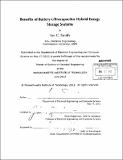| dc.contributor.advisor | John G. Kassakian. | en_US |
| dc.contributor.author | Smith, Ian C., S.M. (Ian Charles). Massachusetts Institute of Technology | en_US |
| dc.contributor.other | Massachusetts Institute of Technology. Dept. of Electrical Engineering and Computer Science. | en_US |
| dc.date.accessioned | 2012-12-13T18:52:01Z | |
| dc.date.available | 2012-12-13T18:52:01Z | |
| dc.date.copyright | 2012 | en_US |
| dc.date.issued | 2012 | en_US |
| dc.identifier.uri | http://hdl.handle.net/1721.1/75685 | |
| dc.description | Thesis (S.M.)--Massachusetts Institute of Technology, Dept. of Electrical Engineering and Computer Science, 2012. | en_US |
| dc.description | Cataloged from PDF version of thesis. | en_US |
| dc.description | Includes bibliographical references (p. 85-88). | en_US |
| dc.description.abstract | This thesis explores the benefits of battery and battery-ultracapacitor hybrid energy storage systems (ESSs) in pulsed-load applications. It investigates and quantifies the benefits of the hybrid ESS over its battery-only counterparts. The metric for quantifying the benefits is charge efficiency - the amount of energy delivered to the load per unit charge supplied by the battery. The efficiency gain is defined as the difference in charge efficiency between the hybrid and the battery-only ESS. A custom experimental apparatus is designed and built to supply the current control for charging and discharging the batteries, as well as the data acquisition for measuring energy and current output. Experiments are performed on both ESSs under four different pulsed load profiles: 1. 436 ms pulse period, 10% duty cycle, 8 A pulse amplitude 2. 436 ms pulse period, 25% duty cycle, 8 A pulse amplitude 3. 436 ms pulse period, 10% duty cycle, 16 A pulse amplitude 4. 436 ms pulse period, 25% duty cycle, 16 A pulse amplitude Circuit models are created to accurately represent the battery and ultracapacitors. These models are used in simulations of the same test cases from the physical experiments, and efficiency gains are compared. The circuit models differed from the experimentation by less than 1%. Both experimental and simulated data demonstrate significantly increased charge efficiencies of hybrid ESSs over battery-only ESSs, with demonstrated gains between 10% and 36%. These benefits were greatest for the 16 A, 10% duty cycle test case because it combined the highest pulse amplitude and the shortest duty cycle. It is concluded that high-amplitude, low duty cycle, and low period pulsedload profiles yield the highest efficiency gains. | en_US |
| dc.description.statementofresponsibility | by .Ian C. Smith | en_US |
| dc.format.extent | 219 p. | en_US |
| dc.language.iso | eng | en_US |
| dc.publisher | Massachusetts Institute of Technology | en_US |
| dc.rights | M.I.T. theses are protected by
copyright. They may be viewed from this source for any purpose, but
reproduction or distribution in any format is prohibited without written
permission. See provided URL for inquiries about permission. | en_US |
| dc.rights.uri | http://dspace.mit.edu/handle/1721.1/7582 | en_US |
| dc.subject | Electrical Engineering and Computer Science. | en_US |
| dc.title | Benefits of battery-uItracapacitor hybrid energy storage systems | en_US |
| dc.type | Thesis | en_US |
| dc.description.degree | S.M. | en_US |
| dc.contributor.department | Massachusetts Institute of Technology. Department of Electrical Engineering and Computer Science | |
| dc.identifier.oclc | 820020565 | en_US |
